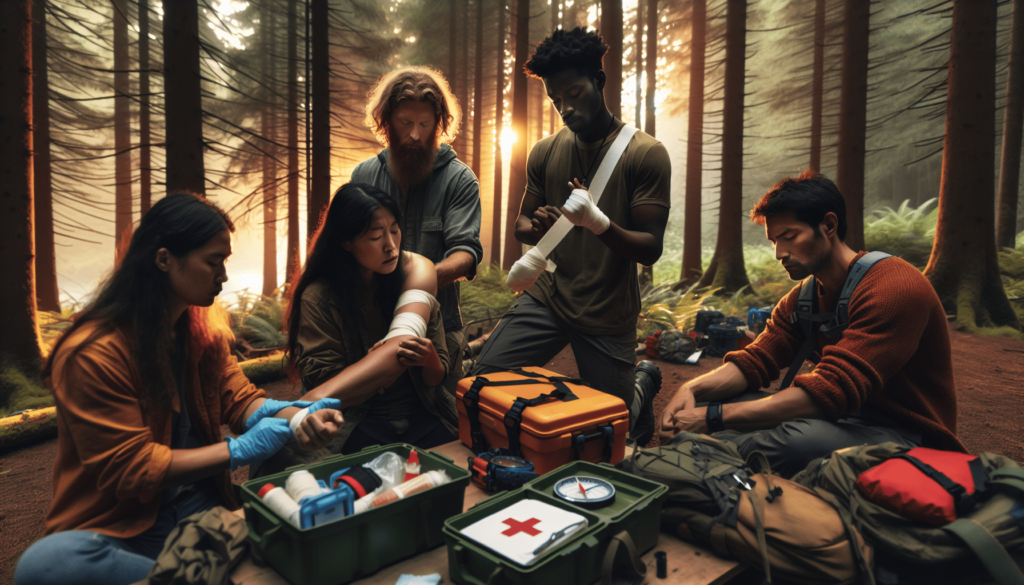Are you ready to conquer the great outdoors? Whether you’re a seasoned adventurer or a curious newbie, it’s crucial to have the skills and knowledge to handle emergencies and injuries in the wilderness. In my blog, “The Survivalist Handbook,” I’ve compiled a wealth of information on wilderness survival, and in my “Wilderness Survival” category, you’ll find a range of articles dedicated to mastering first aid in the wild. From basic techniques to dealing with specific threats and scenarios, equip yourself with the ultimate first aid knowledge that could make all the difference in preserving life and enjoying your wilderness experience to the fullest.

1. Understanding Wilderness First Aid
1.1 What is Wilderness First Aid?
Wilderness First Aid is a specialized form of first aid that focuses on providing medical care in remote and outdoor settings where professional medical help may be difficult to access. It involves the assessment, treatment, and management of injuries and illnesses that can occur in wilderness environments. Unlike traditional first aid, wilderness first aid techniques take into consideration the unique challenges and resources available in the outdoors.
1.2 Importance of Wilderness First Aid
When you venture into the wilderness, you expose yourself to a wide range of risks and potential emergencies. Understanding wilderness first aid is crucial because it equips you with the knowledge and skills to respond effectively to any medical situation that may arise. Whether you are camping, hiking, or participating in outdoor activities, accidents and injuries can happen unexpectedly. Having the ability to provide immediate and appropriate first aid can make a significant difference in the outcome and potentially save lives.
1.3 Basic Principles of Wilderness First Aid
Wilderness first aid follows a set of fundamental principles that guide the approach to providing care in outdoor settings:
Assessing the Situation:
The first step in wilderness first aid is to assess the situation and identify any immediate dangers. This includes evaluating the environment, the injured person’s condition, and the available resources and assistance.
Ensuring Personal Safety:
Before providing any first aid, it is essential to ensure your own safety and the safety of others around you. This may involve assessing for potential hazards, such as unstable terrain or dangerous wildlife.
Prioritizing Injuries:
In a wilderness setting, it is crucial to prioritize injuries based on their severity and the potential impact on the person’s overall health and safety. This helps in determining the order of treatment and allocation of resources.
Stabilizing the Patient:
Once injuries have been assessed and prioritized, it is essential to stabilize the patient’s condition to prevent further harm. This may involve immobilizing fractures, controlling bleeding, or treating other life-threatening conditions.
Seeking Help:
While wilderness first aid aims to provide immediate care, it is important to recognize the limitations of your skills and resources. If the situation is beyond your expertise, it is crucial to seek professional medical help or contact emergency services for assistance.
Continual Monitoring:
Even after initial first aid has been provided, it is important to continually monitor the patient’s condition for any changes or complications. This allows for timely adjustments in treatment and ensures the well-being of the injured person.
2. Essential First Aid Skills for the Outdoors
2.1 Assessing and Prioritizing Injuries
One of the most critical skills in wilderness first aid is the ability to assess injuries and prioritize the order of treatment. This involves gathering information about the nature and severity of the injury, evaluating vital signs, and determining the potential impact on the person’s overall well-being. By assessing injuries effectively, you can make informed decisions regarding the appropriate course of action and ensure that life-threatening conditions are addressed first.
2.2 CPR and Rescue Breathing
Cardiopulmonary Resuscitation (CPR) and rescue breathing are essential skills for wilderness first aid providers. These techniques are used to restore blood circulation and provide oxygen to a person whose breathing or heart function has stopped. CPR involves chest compressions and rescue breathing involves providing breaths to the patient. Proper training in these techniques is crucial, as they can be instrumental in saving lives in emergency situations.
2.3 Treating Bleeding and Wound Care
The ability to control bleeding and provide appropriate wound care is vital in wilderness first aid. In an outdoor environment, injuries such as cuts and lacerations are common, and prompt and effective intervention is necessary to prevent excessive blood loss and reduce the risk of infection. Wilderness first aid training teaches techniques for applying direct pressure, using tourniquets if necessary, and dressing wounds to promote healing and prevent complications.
2.4 Managing Fractures and Sprains
Fractures and sprains can occur when participating in outdoor activities, and knowing how to manage these injuries is essential. Wilderness first aid training covers techniques for immobilizing fractures using improvised splints and slings, as well as providing pain relief and support in the case of sprains. Proper management of these injuries can prevent further damage and facilitate the patient’s safe transportation to a medical facility, if necessary.
2.5 Dealing with Burns and Scalds
Burns and scalds can happen when working with fire, cooking, or due to other accidents in the wilderness. Knowing how to assess the severity of burns, provide immediate first aid, and prevent infection is crucial. Wilderness first aid training equips individuals with knowledge of different burn classifications, appropriate treatment techniques, and how to provide comfort to the injured person until professional medical help can be accessed.
2.6 Handling Allergic Reactions
In the wilderness, encounters with allergens such as insect bites, plants, or certain foods can trigger allergic reactions in some individuals. Wilderness first aid training provides skills and knowledge on recognizing allergic reactions, administering epinephrine auto-injectors for severe cases, and managing lesser reactions with antihistamines. Being prepared to handle allergic reactions can prevent potentially life-threatening situations and provide immediate relief to the affected individual.
2.7 Recognizing and Responding to Heat and Cold-related Injuries
Exposure to extreme temperatures can lead to heat and cold-related injuries in the outdoors. Knowing how to recognize and respond to conditions such as heat exhaustion, heatstroke, hypothermia, and frostbite is crucial in wilderness first aid. Training in this area equips individuals with the skills to assess and manage these conditions, provide proper insulation and warmth, and recognize when a person requires immediate medical attention.
2.8 Treating Insect and Animal Bites
Encounters with insects and animals are inevitable in the wilderness, and it is important to know how to manage the associated bites and stings. Wilderness first aid training covers techniques for identifying and treating bites, including venomous snake bites, bee stings, and spider bites. Knowledge of appropriate response measures and how to transport the patient safely can prevent complications and ensure timely medical care.
2.9 First Aid for Poisoning and Foodborne Illnesses
Ingesting poisonous substances or consuming contaminated food can lead to poisoning or foodborne illnesses while in the wilderness. Wilderness first aid training provides individuals with the skills to recognize the signs and symptoms of poisoning and treat the affected person accordingly. Understanding how to administer first aid measures and support the patient until professional medical help is available is crucial to minimize the impact of poisoning and foodborne illnesses.
3. Wilderness Medications and Medical Equipment
3.1 Choosing and Carrying Essential Medications
When venturing into the wilderness, it is essential to carry essential medications that may be needed in case of emergencies or existing medical conditions. Understanding which medications to include in a wilderness first aid kit, how to store them properly, and when and how to administer them is crucial. Wilderness first aid training provides guidance on medication selection, dosage, and administration to ensure the well-being and safety of individuals in remote locations.
3.2 Utilizing Medical Kits and Equipment in the Wilderness
Having access to appropriate medical kits and equipment can significantly enhance the effectiveness of wilderness first aid. Wilderness first aid training covers information on assembling a comprehensive first aid kit that includes supplies for wound care, splinting, CPR, and other essential interventions. Additionally, individuals are educated on how to effectively use the equipment in the kit and improvise with available resources in emergency situations.
4. Common Wilderness Injuries and Emergencies
4.1 Cuts, Scrapes, and Abrasions
Cuts, scrapes, and abrasions are some of the most common injuries that can occur in the wilderness. Wilderness first aid training provides individuals with knowledge on how to assess the severity of the injury, stop bleeding, clean the wound, and dress it properly to prevent infection. Understanding how to manage these injuries in remote environments ensures prompt and effective treatment.
4.2 Burns and Scalds
Whether from campfires, cooking, or other accidents, burns and scalds are potential injuries in the wilderness. Wilderness first aid equips individuals with the knowledge and skills to assess burn severity, provide immediate first aid, and administer appropriate wound care. Understanding the different types of burns and proper management techniques can prevent complications and promote healing.
4.3 Fractures and Sprains
Fractures and sprains can occur during outdoor activities, and knowing how to manage these injuries is crucial. Wilderness first aid training covers techniques for assessing injuries, immobilizing fractures, providing pain relief, and supporting sprains. By properly handling fractures and sprains, individuals can mitigate further damage and facilitate proper medical care if needed.
4.4 Allergic Reactions and Anaphylaxis
Wilderness environments often expose individuals to allergens that can trigger allergic reactions, including anaphylaxis. Wilderness first aid training provides individuals with skills to recognize mild to severe allergic reactions and administer necessary treatments, such as antihistamines and epinephrine auto-injectors. Prompt recognition and appropriate intervention are vital to prevent life-threatening situations.
4.5 Heat Exhaustion and Heatstroke
Exposure to high temperatures can lead to heat exhaustion or heatstroke in the wilderness. Wildn


